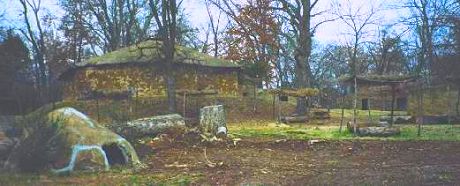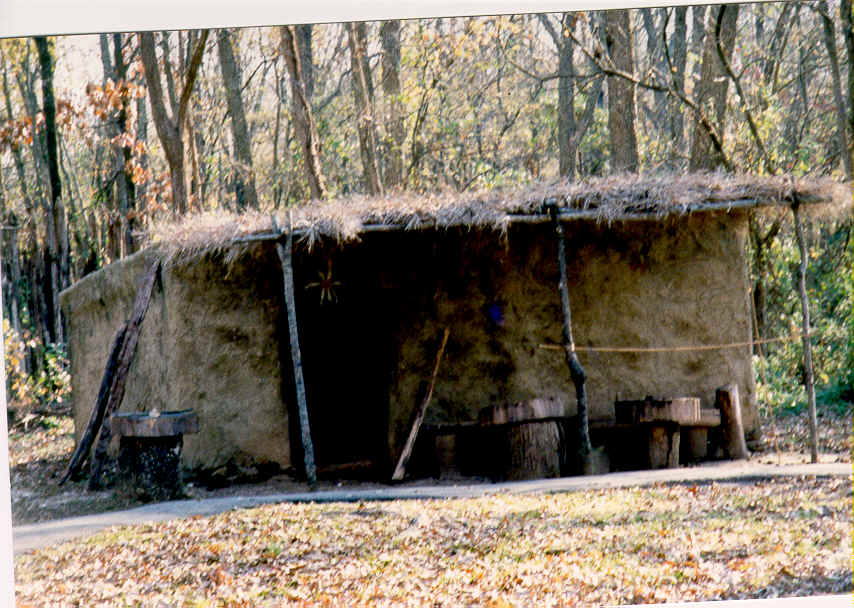Wattle and Daub Houses
Wattle and daub houses (also known as asi, the Cherokee word for them) are Native American houses used by southeastern tribes. Wattle and daub houses are made by weaving rivercane, wood, and vines into a frame, then coating the frame with plaster. The roof was either thatched with grass or shingled with bark.

rivercane frame
 plastered and
thatched
plastered and
thatched Wattle and daub houses are permanent structures that take a lot of effort to build. Like longhouses, they are good homes for agricultural people who intended to stay in one place, like the Cherokees and Creeks. Making wattle and daub houses requires a fairly warm climate to dry the plaster.
The Cherokee Indians lived in settled villages, usually located near a river. Cherokee houses were made of rivercane and plaster, with thatched roofs. These dwellings were about as strong and warm as log cabins.The Cherokees also built larger seven-sided buildings for ceremonial purposes, and each village usually had a ball field with benches for spectators. Many Cherokee villages had palisades (reinforced walls) around them for protection.
At the time of contact, the Cherokee were a settled, agricultural people living in approximately 200 fairly, large villages. The typical Cherokee town consisted of 30 to 60 houses and a large council house. They built permanent, well-organized villages in the midst of extensive cornfields and gardens throughout the fertile river valleys of the Cherokee country.
In these villages, homes ranged around a central plaza used for dances, games, and ceremonies. At one end of the plaza, the council house, or townhouse, held the sacred fire, symbol of the Creator and embodiment of the spirit of the town. Often the townhouse stood on an earthen mound from the earlier Mississippian culture, although the Cherokee themselves did not build mounds during the historic period. However, the mounds sometimes grew with successive, ceremonial rebuildings.
 |
| Ancient Cherokee Village |
 |
| Cherokee Summer House |
 |
| Cherokee Winter House |
In later years, many Cherokee, lived in the same kind of houses the European settlers lived in -- log cabins and wooden houses. A typical log cabin had one door and a smoke hole in the center of the roof.
Cherokee Clothing


Breechcloths leave the legs bare, so Native American men often wore leggings to protect their legs. Native American leggings are tube-like footless pant legs, usually made from buckskin or other soft leather. They are not connected to each other--there is one separate legging for each leg. Both leggings are tied onto the same belt that holds the breechcloth with thongs that attach at the hip.
Legging styles varied from tribe to tribe. Sometimes they were fringed, like the ones in this picture. Sometimes they were painted with colorful patterns or decorated with beadwork or quillwork designs. Many Indian men tied garters (straps, thongs, or bandana-like cloths) around their leggings at the knee to help keep them in place.
Women and girls also wore leggings in many tribes, but female leggings were shorter and were not attached to a belt, simply gartered at the knee.
| A breechcloth is a long rectangular piece
of tanned deerskin, cloth, or animal fur. It is worn between the legs and tucked
over a belt, so that the flaps fall down in front and behind. Sometimes it is
also called a breechclout, loincloth, skin clout, or just a
flap. In most Native American tribes, men used to wear some form of breechclout. The style was different from tribe to tribe. In some tribes, the breechcloth loops outside of the belt and then is tucked into the inside, for a more fitted look. Sometimes the breechcloth is much shorter and a decorated apron panel is attached in front and behind. A Native American woman or teenage girl might also wear a fitted breechcloth underneath her skirt, but not as outerwear. However, in many tribes young girls did wear breechcloths like the boys until they became old enough for skirts and dresses Transportation |
The Cherokee Indians used to make long dugout canoes from hollowed-out logs.
Over land, the Cherokees used dogs as pack animals. There were no horses in
North America until colonists brought them over from Europe.

read the sackeett books about that
ReplyDelete